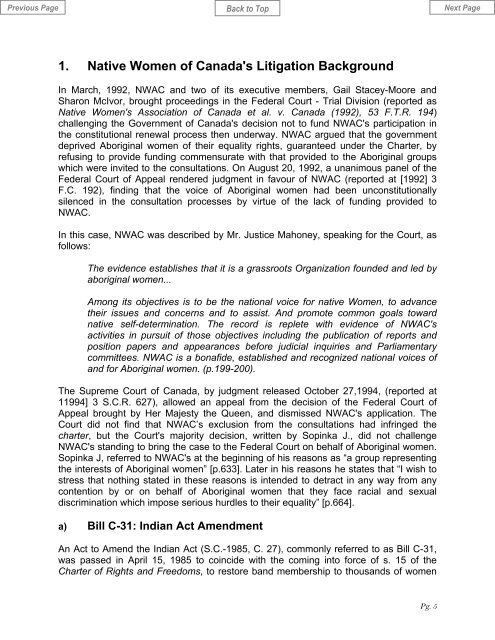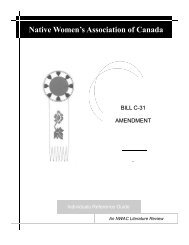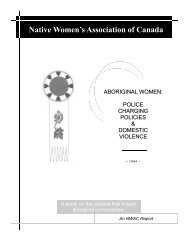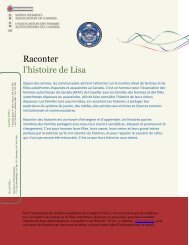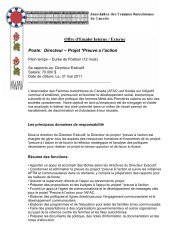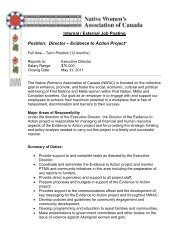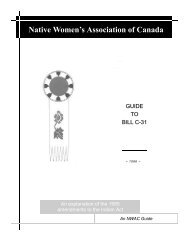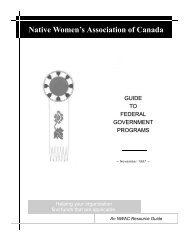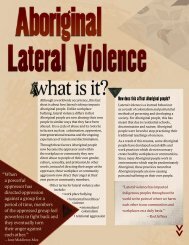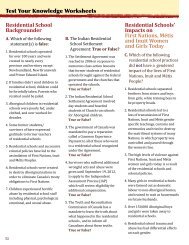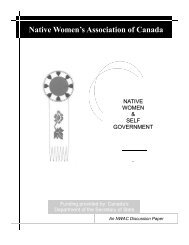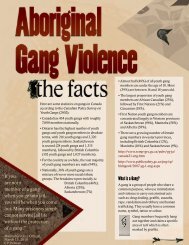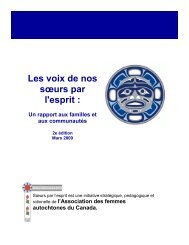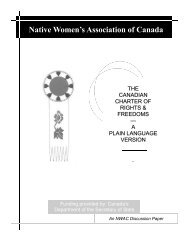BILL C-31 - Native Women's Association of Canada Website
BILL C-31 - Native Women's Association of Canada Website
BILL C-31 - Native Women's Association of Canada Website
- No tags were found...
Create successful ePaper yourself
Turn your PDF publications into a flip-book with our unique Google optimized e-Paper software.
1. <strong>Native</strong> Women <strong>of</strong> <strong>Canada</strong>'s Litigation BackgroundIn March, 1992, NWAC and two <strong>of</strong> its executive members, Gail Stacey-Moore andSharon McIvor, brought proceedings in the Federal Court - Trial Division (reported as<strong>Native</strong> <strong>Women's</strong> <strong>Association</strong> <strong>of</strong> <strong>Canada</strong> et al. v. <strong>Canada</strong> (1992), 53 F.T.R. 194)challenging the Government <strong>of</strong> <strong>Canada</strong>'s decision not to fund NWAC's participation inthe constitutional renewal process then underway. NWAC argued that the governmentdeprived Aboriginal women <strong>of</strong> their equality rights, guaranteed under the Charter, byrefusing to provide funding commensurate with that provided to the Aboriginal groupswhich were invited to the consultations. On August 20, 1992, a unanimous panel <strong>of</strong> theFederal Court <strong>of</strong> Appeal rendered judgment in favour <strong>of</strong> NWAC (reported at [1992] 3F.C. 192), finding that the voice <strong>of</strong> Aboriginal women had been unconstitutionallysilenced in the consultation processes by virtue <strong>of</strong> the lack <strong>of</strong> funding provided toNWAC.In this case, NWAC was described by Mr. Justice Mahoney, speaking for the Court, asfollows:The evidence establishes that it is a grassroots Organization founded and led byaboriginal women...Among its objectives is to be the national voice for native Women, to advancetheir issues and concerns and to assist. And promote common goals towardnative self-determination. The record is replete with evidence <strong>of</strong> NWAC'sactivities in pursuit <strong>of</strong> those objectives including the publication <strong>of</strong> reports andposition papers and appearances before judicial inquiries and Parliamentarycommittees. NWAC is a bonafide, established and recognized national voices <strong>of</strong>and for Aboriginal women. (p.199-200).The Supreme Court <strong>of</strong> <strong>Canada</strong>, by judgment released October 27,1994, (reported at11994] 3 S.C.R. 627), allowed an appeal from the decision <strong>of</strong> the Federal Court <strong>of</strong>Appeal brought by Her Majesty the Queen, and dismissed NWAC's application. TheCourt did not find that NWAC’s exclusion from the consultations had infringed thecharter, but the Court's majority decision, written by Sopinka J., did not challengeNWAC's standing to bring the case to the Federal Court on behalf <strong>of</strong> Aboriginal women.Sopinka J, referred to NWAC's at the beginning <strong>of</strong> his reasons as “a group representingthe interests <strong>of</strong> Aboriginal women” [p.633]. Later in his reasons he states that “I wish tostress that nothing stated in these reasons is intended to detract in any way from anycontention by or on behalf <strong>of</strong> Aboriginal women that they face racial and sexualdiscrimination which impose serious hurdles to their equality” [p.664].a) Bill C-<strong>31</strong>: Indian Act AmendmentAn Act to Amend the Indian Act (S.C.-1985, C. 27), commonly referred to as Bill C-<strong>31</strong>,was passed in April 15, 1985 to coincide with the coming into force <strong>of</strong> s. 15 <strong>of</strong> theCharter <strong>of</strong> Rights and Freedoms, to restore band membership to thousands <strong>of</strong> womenPg. 5


